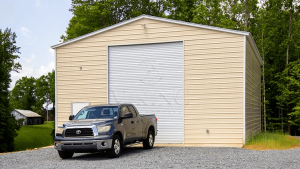Building A Metal Workshop: A Step-By-Step Guide

According to the Today’s Homeowner survey, nine out of ten Americans have home improvement projects planned for 2023 & most of them are thinking of DIY-ing these projects. Do you happen to be one of them? Thinking of installing a metal workshop on your property? If yes, let’s go.
Installing a DIY steel workshop can be tricky. You may think it requires professional-level experience. Even though it is partly true, there is a cheat sheet. If you have done construction work before, this may come in handy. A prefab metal workshop kit will be the best option for you as most of the hard work comes pre-done from the factory.
Here Are Some Tips and Tricks to Construct Metal Warehouses for You.
1. Determine The Size
What size metal warehouses do you want to construct? Well, you see, the answer to that question depends on-
- Space available,
- Your local building code guidelines,
- And your budget.
The standard US warehouse size is larger than 25,000 square feet. Only 35% of warehouses are smaller than this. Meanwhile, 50% are 50,001 square feet or more [source: website]. This site is usually for commercial purposes. But don’t be disheartened. You can build metal warehouses for sizes such as 20x25x10, 48x31x12 with vertical roofs for about $14,525, or 44x40x12 with a raised center for around $24,772.
2. Calculate Cost of Raw Materials
The amount of raw material will depend upon the dimensions of your steel building. Now, here is another trick. If you want to save money on size, go for more length than width. You see, adding length to your building costs you less than adding width.
3. Drawing
At times, it can get a little confusing. Hence, I prefer a drawing of your structure. This will keep you on the path & on time. Also, you will have a clear idea of what you are installing.
4. Gather All Necessary Tools for Construction
If you are going to DIY metal buildings, you are going to need all the necessary tools. Some of the most common ones are-
- Anvil
- Step ladder
- Measuring tape
- Leveler
- Welding gloves
- Screwdriver
- Soapstone for marking metal (avoid using graphite pencils as they can cause rusting in the long run)
- Clamps
- Drill machine (you can get the whole set online these days)
You may need more tools depending on the complexity of your construction.
5. Consider Insulations & Adequate Vents
It is best to install an insulator to prevent condensation during the time of installation. After that, it may cost you more. If you are thinking of adding gravity vents, windows, or larger roll-up doors, include them in your design before beginning installation. Any cutting of metal panels after construction will take extra effort and time.
6. Seal The Whole Structure
Metal warehouses are used to store inventories, to be used as a workshop, or for other purposes. It involves human occupants. Hence, it needs to be appropriately sealed to ensure that the HAVC system works with total efficiency.
A sealed metal structure will take less time to cool or warm up. Once cooled or warmed, it maintains the temperature for longer.
7. Buy During Best Time of The Year
Running short on budget? Don’t worry. Get your steel building for sale. Many steel builders offer steel buildings for sale or discount during the holiday season. So, keep an eye online. You may end up with a favorable deal for a reasonable price.
Budget Tip: Go for Pre-Engineered Design
A pre-engineered structure is cut, drilled, & designed in the factory itself. They are best for DIY steel workshops. Since most of the work is pre-done, it is easy for a person to install it by self. Not to mention, prefabricated metal buildings cost less than the custom-designed metal structure.
Now that we are done with the basis, let’s move on to the installation part.
A Step By Step Guide For Metal Building Construction
1. Clear of The Site From Any Debris
Before you begin installation, you will need to clear your site. Try to remove any boulders, rocks, vegetation, or plantation. Fill up any pothole on the ground & level it up.
2. Pour Foundation
Since metal warehouses are relatively large structures, you will need to get a concrete foundation for them. Concrete takes time to set, so pour your foundation a week before installation begins. Allow your foundation to set.
3. Next Comes Anchors, and Columns
After you are done pouring the base, place anchors in the concrete foundation while it is still setting. After the anchor, next comes the support column. You can choose to have a side support or support column inside the building.
For a steel workshop, we recommend that you choose a column-free structure for maximum interior space.
4. Install Metal Posts
Install metal posts and tighten them with screws, nuts, and bolts. You are going to need a drill machine, so keep it handy.
5. Finally, Time to Attach Frames and Trusses
Frames are the skeleton for your metal buildings. So, be very careful while placing them. You may need the help of large construction machinery to uplift it so that it can be fastened with the metal post.
After frames, you can add trusses to secure it and divide the weight equally on the post & foundation.
6. Next, Install Overhead Windows & Door Jambs
Your doors & windows are going to need a frame to be installed. An overhead for doors will do the job pretty well.
7. Add-Ons (Insulator, Gutter, Downspout, etc.)
Finally, when you are done installing side metal panels, add an insulator. You can opt for fiberglass as it comes in various R-ratings and is affordable.
And lastly, add trim and gutter to your metal structure. You won’t want water to fall directly on your head as you walk in or out of the building. It would be helpful if you take one step further and add a downspout. This will redirect all rainwater to a specific place. You may even collect this water and recycle it for use.
Note: Examine all nuts & bolts are in place & placed properly. Any loose or missing nuts/bolts can cause damage in the future.
In Conclusion, We Can Say
Constructing a metal warehouse does not require any rocket science level expertise. However, one should note that metal buildings are meant for precision. So, while you do DIY, ensure that no material is missing. After every step completion, check to see if things are going in the correct order.
Nothing should be missing, not even one nut from the whole structure. And voila, your steel workshop is ready within a few weeks of your determination. Don’t forget to pat your back. You have finished a project successfully; well done.






